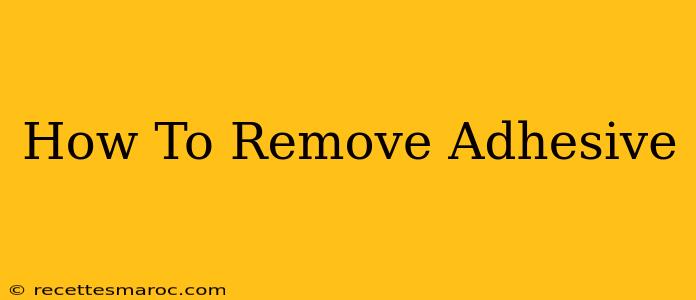Sticky situations got you down? Whether it's stubborn glue residue from a DIY project, the remnants of a price sticker, or that pesky double-sided tape refusing to let go, removing adhesive can be a frustrating experience. But fear not! This comprehensive guide will equip you with the knowledge and techniques to conquer any adhesive challenge, leaving your surfaces clean and residue-free.
Understanding the Enemy: Different Adhesives, Different Approaches
Before diving into removal methods, it's crucial to identify the type of adhesive you're dealing with. Different adhesives require different approaches, and using the wrong method can damage the underlying surface.
Common Adhesive Types and Their Characteristics:
- Glue: This broad category encompasses many types, from water-based glues (easily removable with water) to super glues (requiring more aggressive techniques).
- Double-Sided Tape: Known for its strong bond, double-sided tape often leaves a tenacious residue.
- Sticker Residue: These typically leave behind a thin, sticky film that can be surprisingly difficult to remove.
- Masking Tape: Generally easier to remove, but can still leave behind stubborn residue, especially after prolonged exposure to the elements.
- Hot Glue: This requires a different approach due to its high melting point.
Safe and Effective Adhesive Removal Techniques
Now that we understand the variety of adhesives, let's explore safe and effective removal methods:
1. The Gentle Approach: For Minor Adhesive Residue
- Warm Water and Soap: For many minor adhesive messes, a simple solution of warm water and dish soap can work wonders. Apply the solution, let it sit for a few minutes, and then gently scrub with a soft cloth or sponge.
- Isopropyl Alcohol (Rubbing Alcohol): A mild solvent, isopropyl alcohol effectively dissolves many adhesives. Apply it to a soft cloth and gently rub the affected area. Always test in an inconspicuous area first to ensure it doesn't damage the surface.
2. The Medium Approach: Tackling Stubborn Adhesives
- Vegetable Oil: Surprisingly effective, vegetable oil can soften and loosen many adhesives. Apply a small amount, let it sit for a few minutes, and then wipe away with a clean cloth.
- Baking Soda Paste: Create a paste of baking soda and water. Apply it to the adhesive residue, let it dry, and then scrub it away. This method is particularly useful for greasy adhesive residue.
- Commercial Adhesive Removers: Various commercial adhesive removers are available, designed for specific types of adhesive. Always read the instructions carefully and follow safety precautions.
3. The Heavy-Duty Approach: For the Most Stubborn Adhesives
- Heat: For stubborn adhesives like hot glue or certain types of tape, applying heat can help soften the adhesive, making it easier to remove. Use a hairdryer on a low setting or a heat gun (use caution with heat guns as they can damage surfaces).
- Peanut Butter: Yes, you read that right! The oils in peanut butter can help break down some stubborn adhesives. Apply it, let it sit, and then wipe away.
Preventing Future Adhesive Headaches
Prevention is key! Here are some tips to minimize future adhesive removal hassles:
- Use appropriate adhesives: Choose the right adhesive for the job to avoid unnecessary strength.
- Protect surfaces: Use masking tape or other protective coverings when working with adhesives.
- Clean up promptly: Remove adhesive residue as soon as possible for easier removal.
Conclusion: A Clean Slate Awaits
Removing adhesive doesn't have to be a battle. By understanding the type of adhesive and employing the appropriate techniques, you can conquer sticky situations and achieve a clean, residue-free finish. Remember to always test any cleaning solution on an inconspicuous area first and exercise caution when using heat or solvents. With a little patience and the right approach, you'll be enjoying your clean surfaces in no time!

